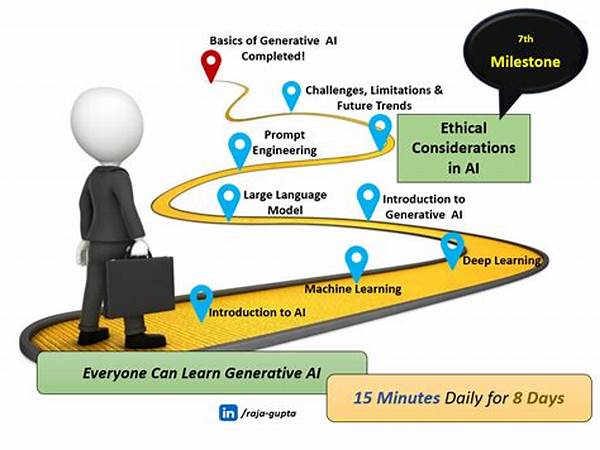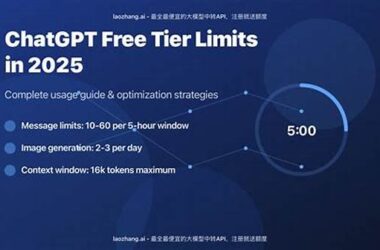- Transitioning from Tutorials to Real-World AI Applications
- Understanding the Tutorial Trap in AI Learning
- Embracing Complexity and Failure as Learning Tools
- Transitioning from Structured to Unstructured Learning
- Building Confidence for Independent AI Projects
- Continuous Learning and Adaptation in AI
- Topics Relevant to Breaking the Tutorial Trap
- Introduction: Breaking Free from the Tutorial Loop
- Practical Steps to Overcome the Tutorial Pitfall
- Leveraging Community and Mentorship
- Illustrations of the Tutorial Trap Solution
- Overcoming the Tutorial Limitation: A Deep Dive
Artificial Intelligence (AI) is rapidly revolutionizing industries and impacting daily life significantly. The potential of AI can be seen in smart devices, healthcare advancements, and even self-driving cars. For enthusiasts eager to dive into this fascinating world, online tutorials often serve as the initial doorway. However, many beginners find themselves trapped in the tutorial phase, unable to transition to advanced levels. What’s the culprit? The #1 learning mistake that keeps AI beginners stuck in the tutorial phase!
Read More : Ai Animating Beginner Notebook.ipynb
Imagine this: You’ve watched countless YouTube videos and online courses about AI, but when it comes to applying the knowledge, you freeze. It’s a frustrating loop. Tutorials provide a structured approach, and it’s tempting to think mastering them equates to mastering AI. But there’s a catch; without real-world application, this knowledge remains theoretical. Simply put, the mistake lies in an over-reliance on tutorials. They’re excellent for foundational understanding, but the world of AI demands practical experimentation and problem-solving beyond any scripted lesson.
True mastery in AI, like any other skill, requires stepping out of the comfort zone. It’s about tackling AI projects that spark your passion or solve pressing problems. Whether it’s creating your own neural network or working on AI open-source projects, these practical experiences accelerate learning. Overcoming the tutorial trap requires a shift from passive consumption of information to active experimentation and creation. This step is crucial in transforming knowledge into skill and ensuring you don’t remain in the beginner’s loop.
Transitioning from Tutorials to Real-World AI Applications
The path to AI mastery is paved with real-world projects and hands-on experience. Nevertheless, the allure of online tutorials as a comfortable and guided learning path can maintain the hold that is the #1 learning mistake that keeps AI beginners stuck in the tutorial phase. Breaking free involves challenging oneself with projects that lack step-by-step solutions, prompting the critical thinking and problem-solving skills that are hallmarks of proficient AI developers.
—
Understanding the Tutorial Trap in AI Learning
The pervasive reliance on tutorials in AI can surprisingly be short-term gain overshadowing long-term skill development. Many beginners, eager to grasp the basics, inundate themselves with tutorials without sparing a thought for application. This behavior not only limits creativity but also fosters a false sense of competence. The crux of the problem, the #1 learning mistake that keeps AI beginners stuck in the tutorial phase, is a perceived plateau where individuals feel knowledgeable but can’t progress independently.
Continuing in a cyclical pattern of watching and following without creating restricts the neural pathways to critical thinking, a vital aspect of AI advancement. As tutorials often provide a fixed set of outcomes, they stifle the learner’s ability to explore alternative solutions or innovate beyond the confines of pre-defined answers.
This reliance poses a challenge, primarily when transitions to real-world applications are required. The real world doesn’t have “guides” or “walkthroughs” for every conceivable situation, so why do we apply this method to AI learning? Often, beginners blame complexity or the fear of failure, which indeed are valid concerns but needed hurdles to jump over to attain mastery.
Fear not, as each AI journey is unique, and success isn’t a linear path. Engagement in brainstorming sessions, collaboration on community projects, and daring experiments all promote the diversified learning required to advance beyond the tutorial. Many new learners shy away from this uncharted territory, succumbing to the comfort of predictable outcomes in tutorials while missing out on explorative opportunities for advancement.
Embracing Complexity and Failure as Learning Tools
A common sentiment among AI beginners is frustration, especially when expected results don’t materialize. However, what separates an expert from a beginner is the comfort in navigating and embracing failure as a pivotal learning tool. Rather than feeling defeated, each failed experiment acts as a stepping stone, a test in resilience and curiosity, promoting growth beyond what tutorials teach.
Developing a mindset shift where complexity is embraced and failure is a pathway to innovative solutions propels learners into skill acquisition realms previously thought unattainable. The #1 learning mistake that keeps AI beginners stuck in the tutorial phase is a fallacy rooted in comfort, and thriving begins where comfort ends—beyond tutorials, into the playground of practical application.
Transitioning from Structured to Unstructured Learning
In moving from structured tutorials to an unstructured, problem-solving environment, the first step is acknowledging the gap between academic learning and real-life application. AI, fundamentally, is about curiosity, experimentation, and redefining societal paradigms, which inherently implies periods of trial and error absent in well-laid guides.
Starting independent projects, contributing to open-source platforms, or engaging in online forums can bridge the gap. Interacting with more experienced AI practitioners also reveals the unglorified reality of failed models, scripting errors, and data mishaps—all integral components of the learning curve.
Building Confidence for Independent AI Projects
Confidence in AI skills isn’t cultivated by flawless tutorial execution but by navigating the uncertainty of independent projects. Begin with manageable, personal AI issues—whether that’s using AI for data analysis on a favorite sports team or creating a chatbot for a pet project. Autonomy in project selection and execution encourages an understanding of the full development cycle, enkindling confidence needed to tackle larger, more complex problems.
Seek mentorship within the AI community. Having a mentor guide through complex topics or provide feedback on projects turns theoretical knowledge into applied science, progressively raising the skill ceiling. This step, vital in eschewing the #1 learning mistake that keeps AI beginners stuck in the tutorial phase, lays the groundwork for future exploration and innovation.
Continuous Learning and Adaptation in AI
AI is an ever-evolving field demanding continuous learning and adaptation. As technology adapts, beginners should cultivate a habit of proactive learning beyond traditional paths. Engage with AI-focused seminars, read relevant research papers, and stay up-to-date with technological trends. Awareness of global project initiatives and advancements not only breaks the tutorial stranglehold but also embeds the learner in the living, breathing ecosystem of AI development.
Seek constructive feedback from peers and mentors consistently, broadening perspectives, and deepening problem-solving approaches. The journey doesn’t have to be lonely—take a community-building approach, share your findings, and celebrate small victories to propel motivation in this never-ending voyage of learning.
Topics Relevant to Breaking the Tutorial Trap
Here are some engaging topics that relate to overcoming the #1 learning mistake that keeps AI beginners stuck in the tutorial phase:
Introduction: Breaking Free from the Tutorial Loop
Artificial Intelligence beginners often find themselves enamored with the promises of endless possibilities found within the domain. Tutorials are typically the first stop, offering a controlled entry into the world of AI, complete with guided examples and predictable outcomes. Yet, a common roadblock impedes progress—the perils of over-relying on them, known as the #1 learning mistake that keeps AI beginners stuck in the tutorial phase.
For most beginners, the infinite pool of available tutorials creates an illusionary mastery. This reliance may give a false sense of advancement, yet many find themselves floundering when real-world applications demand more than theoretical know-how. Tutorials, while extensive, can’t offer the deep, critical insight that working on a project, engaging in problem-solving, or battling through coding errors can provide. This limitation stifles creativity, innovation, and, ultimately, the depth of learning critical to success in the field of AI.
Tackling this roadblock involves breaking free and engaging with real-world problems, and getting comfortable with creating something original, even if it starts small. The transition from learner to doer is transformative, fostering independence and resilience. It’s about embracing AI as a living, evolving entity outside of neatly packaged tutorials, diving into complexity, and evolving continuously with hands-on, real-world experience.
Practical Steps to Overcome the Tutorial Pitfall
Understanding the Impact of the Tutorial Trap
The #1 learning mistake amongst beginners is viewing tutorials as the endpoint rather than the starting line. The shift requires breaking perceived barriers around the complexity of independent exploration.
Developing a Self-Sufficient Learning Approach
Creating a personal roadmap can help. Mapping out specific interests, desired skills, and potential projects can guide beginners from dependence on guides to a more independent learning pathway.
Leveraging Community and Mentorship
Beyond tutorials, engaging with peers accelerates learning. Involvement in online AI communities, discussion forums, and mentorships offers insights and troubleshooting support from those who’ve successfully made the transition.
Creating success in AI demands patience, experimentations, and a willingness to accept and learn from failure. Free from the tutorial hand-holding, the learning journey becomes less a mapped path and more an innovative adventure.
By synthesizing guided learning with hands-on experimentation, beginners can navigate the tutorial trap, and eventually, carve out their unique space in the expansive field of AI. This transformative journey not only enhances individual skillsets but also fuels creativity and innovation within the broader AI community.
Illustrations of the Tutorial Trap Solution
Here are six illustrations to visualize overcoming the #1 learning mistake that keeps AI beginners stuck in the tutorial phase:
Overcoming the Tutorial Limitation: A Deep Dive
Relying excessively on tutorials is the quintessential trap experienced by AI beginners, hindering their emotional and rational progression in the field. Tutorials are valuable educational resources but cannot encompass the actual problem-solving experiences essential in mastering AI.
The key is to recognize when tutorials shift from being a resource to a crutch. This shift is observable when beginners find comfort in the predictability offered by guided lessons but struggle to apply concepts to original problems or projects.
Embracing AI Complexities as Learning Catalysts
Confronting confusion or encountering unsolved challenges is not a setback but a crucial aspect of authentic learning. The turning point involves nurturing a mindset that views these hurdles as opportunities—each breakdown leading to breakthroughs by uncovering unknown personal capabilities or unique solutions others might overlook.
Emerging from the tutorial trap and becoming competent in AI necessitates innovation, curiosity, and resilience facilitated by self-directed learning, collaboration, and real-world problem-solving. Balancing initial structured learning with expansive, experiential engagement allows AI beginners to evolve into proficient practitioners and contributors in the dynamic world of AI.



